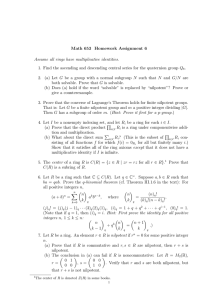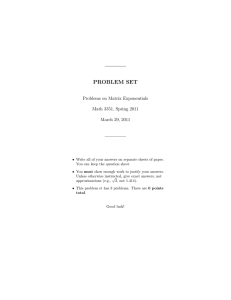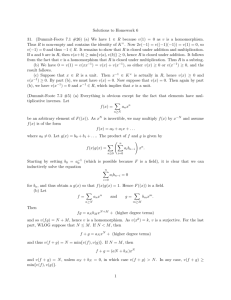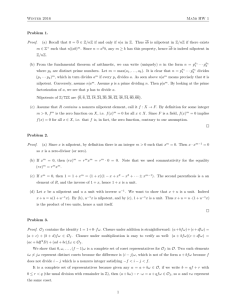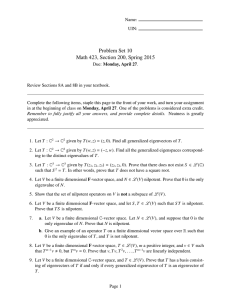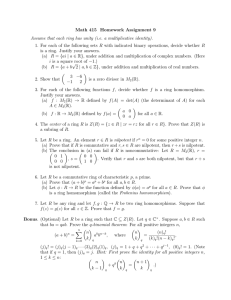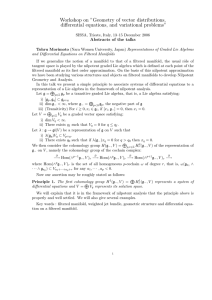Nilpotence 1 Various forms of nilpotence Callan McGill
advertisement
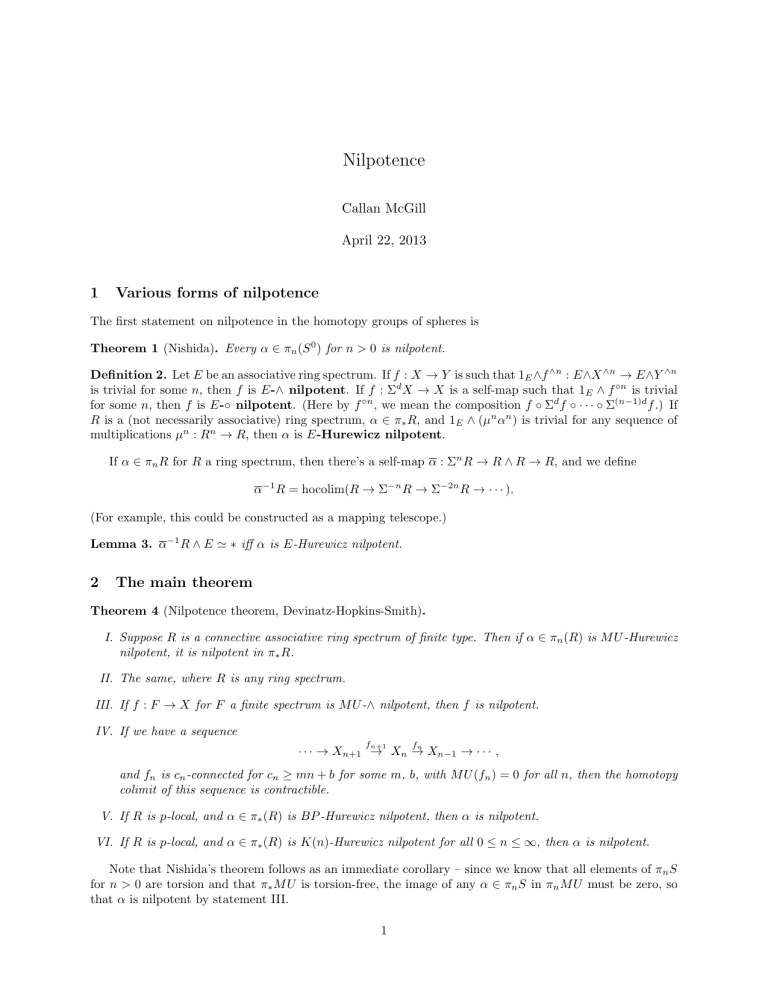
Nilpotence
Callan McGill
April 22, 2013
1
Various forms of nilpotence
The first statement on nilpotence in the homotopy groups of spheres is
Theorem 1 (Nishida). Every α ∈ πn (S 0 ) for n > 0 is nilpotent.
Definition 2. Let E be an associative ring spectrum. If f : X → Y is such that 1E ∧f ∧n : E∧X ∧n → E∧Y ∧n
is trivial for some n, then f is E-∧ nilpotent. If f : Σd X → X is a self-map such that 1E ∧ f ◦n is trivial
for some n, then f is E-◦ nilpotent. (Here by f ◦n , we mean the composition f ◦ Σd f ◦ · · · ◦ Σ(n−1)d f .) If
R is a (not necessarily associative) ring spectrum, α ∈ π∗ R, and 1E ∧ (µn αn ) is trivial for any sequence of
multiplications µn : Rn → R, then α is E-Hurewicz nilpotent.
If α ∈ πn R for R a ring spectrum, then there’s a self-map α : Σn R → R ∧ R → R, and we define
α−1 R = hocolim(R → Σ−n R → Σ−2n R → · · · ).
(For example, this could be constructed as a mapping telescope.)
Lemma 3. α−1 R ∧ E ' ∗ iff α is E-Hurewicz nilpotent.
2
The main theorem
Theorem 4 (Nilpotence theorem, Devinatz-Hopkins-Smith).
I. Suppose R is a connective associative ring spectrum of finite type. Then if α ∈ πn (R) is M U -Hurewicz
nilpotent, it is nilpotent in π∗ R.
II. The same, where R is any ring spectrum.
III. If f : F → X for F a finite spectrum is M U -∧ nilpotent, then f is nilpotent.
IV. If we have a sequence
fn+1
fn
· · · → Xn+1 → Xn → Xn−1 → · · · ,
and fn is cn -connected for cn ≥ mn + b for some m, b, with M U (fn ) = 0 for all n, then the homotopy
colimit of this sequence is contractible.
V. If R is p-local, and α ∈ π∗ (R) is BP -Hurewicz nilpotent, then α is nilpotent.
VI. If R is p-local, and α ∈ π∗ (R) is K(n)-Hurewicz nilpotent for all 0 ≤ n ≤ ∞, then α is nilpotent.
Note that Nishida’s theorem follows as an immediate corollary – since we know that all elements of πn S
for n > 0 are torsion and that π∗ M U is torsion-free, the image of any α ∈ πn S in πn M U must be zero, so
that α is nilpotent by statement III.
1
2
Proof of I ⇒ III. Suppose that α : F → X is M U -∧ nilpotent; replacing F and X with sufficiently high
smash powers, we see that 1 ∧ α : M U ∧ F → M U ∧ X is zero. SInce F is finite, it has a Spanier-Whitehead
dual DF , and α : S → X ∧ DF is zero after smashing with M U . Since S is a small object, the image of
this map is some finite subspectrum of X ∧ DF , and any given nullhomotopy must likewise factor through
some finite subspectrum. Let X 0 be suchWa subspectrum; after sufficient suspension, we can take X 0 to be
connective. The tensor algebra T (X 0 ) = n≥0 (X 0 )∧n is then a connective associative ring spectrum of finite
type, and if i : X 0 → T (X 0 ) is the inclusion, then i∗ α is M U -Hurewicz nilpotent in T (X 0 ), so by I, α is
nilpotent, and thus α is nilpotent.
III ⇒ II. Suppose α ∈ πn (R) is M U -Hurewicz nilpotent, so that M U ∧ S n → M U ∧ M U ∧ R → M U ∧ R
is nilpotent. It immediately follows that α is nilpotent.
III ⇒ IV. See the DHS paper.
II ⇒ V. This follows from the splitting of M U(p) .
V ⇒ VI. We have hBP i = hK(0)i ∨ · · · ∨ hK(n)i ∨ hP (n + 1)i, where angle brackets denote the Bousfield
class and P (n + 1) is the cohomology theory with P (n + 1)∗ = Z(p) [vn+1 , . . . ]. Note that lim P (n) = HFp .
−→
Thus if f : F → X is K(n)-Hurewicz nilpotent for all n, then F → lim P (n) ∧ X factors through some
←−
P (n) ∧ X, and it is therefore BP -Hurewicz nilpotent, thus nilpotent by V.
The nilpotence theorem resolves the following conjecture:
Conjecture 5 (Ravenel’s nilpotence conjecture). If we have f : Σd X → X with M U∗ (f ) = 0, and X is
finite, then f is composition nilpotent.
Proof. The mapping telescope of f is contractible, so some composite of f is zero.
Outline of proof of the nilpotence theorem. We’ve reduced the theorem to proving I. We have a sequence of
maps
∗ ' ΩSU (1) → ΩSU (2) → · · · → ΩSU → BU.
If X(n) is the Thom spectrum of ΩSU (n) → BU , then we can write M U as a colimit
S 0 = X(0) → X(1) → · · · → X(∞) → M U,
where X(n) → M U is 2n − 1-connected. Thus if α ∈ πd (R) has zero M U -Hurewicz image, it also has zero
X(n)-Hurewicz image for sufficiently large n.
We thus reduce to showing that if α is X(n + 1)-Hurewicz nilpotent, then it is X(n)-Hurewicz nilpotent.
As usual, it suffices to look locally at each p; this is sketched out below.
3
Homology of various spaces
Fix L0 ∈ CP n−1 . We have a map ΣCP n−1 → SU (n) given by (z, L) 7→ (z −1 πL0 + πL⊥
)(zπL + πL⊥ ). The
0
adjoint maps CP n−1 → ΩSU (n) are compatible with the inclusions CP n−1 ,→ CP n , ΩSU (n) ,→ ΩSU (n+1),
and thus we get a map CP ∞ → ΩSU → BU .
Let V be the virtual vector bundle O(−1) − 1 over CP n−1 . Then the Thom spectrum (CP n−1 )V is
−2
Σ CP n , and we get complex n-orientations Σ−2 CP n → X(n) for each n with colimit Σ−2 CP ∞ → M U . We
have H∗ (CP n−1 ) = Z{β0 , . . . , βn }, and such an identification induces H∗ (ΩSU (n)) = Z[β0 , . . . , βn ]/(β0 − 1).
The Thom isomorphism gives H∗ (X(n)) = Z[b0 , . . . , bn ]/(b0 − 1), where bi comes from Σ−2 CP n+1 .
Proposition 6. Suppose k ≤ n. Then X(n)∗ CP k = X(n)∗ {β1 , . . . , βk }, and X(n)∗ X(k) = X(n)∗ [b0 , . . . , bk ]/(b0 −
1).
Theorem 7. X(n)∗ X(n) is flat over X(n).
4. FURTHER REDUCTIONS
4
3
Further reductions
There’s a pullback square
0
Fk,n
/ ΩSU (n + 1)
Jk S 2n
/ ΩS 2n+1 .
0
Write Fk,n for the Thom spectrum of Fk,n
→ ΩSU (n + 1) → BU . We have maps
F0,n = X(n) → F1,n → · · · → X(n + 1),
and we define Gk,n = (Fpk−1 ,n )(p) .
Theorem 8. if X(n + 1) ∧ α−1 R ' ∗ then Gk,n ∧ α−1 R ' ∗ for large enough k.
Theorem 9. hGk,n i = hGk+1,n i as Bousfield classes.
Thus, G0,n ∧ α−1 R ' ∗, and it follows that X(n)(p) ∧ α−1 R ' ∗, as desired.
